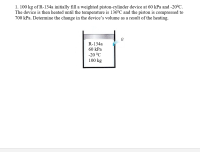
Elements Of Electromagnetics
7th Edition
ISBN: 9780190698614
Author: Sadiku, Matthew N. O.
Publisher: Oxford University Press
expand_more
expand_more
format_list_bulleted
Concept explainers
Question

Transcribed Image Text:### Problem Statement:
**1. 100 kg of R-134a initially fill a weighted piston-cylinder device at 60 kPa and -20°C. The device is then heated until the temperature is 136°C and the piston is compressed to 700 kPa. Determine the change in the device’s volume as a result of the heating.**
### Diagram Description:
The accompanying diagram illustrates a weighted piston-cylinder device containing 100 kg of R-134a, a refrigerant. The initial states of the refrigerant are:
- Pressure: 60 kPa
- Temperature: -20°C
The device undergoes a heating process, which results in the following final states:
- Temperature: 136°C
- Pressure: 700 kPa
The diagram shows a piston in a cylinder with labels indicating the initial and final states of pressure, temperature, and mass of the refrigerant.
### Solution Approach:
The problem requires finding the change in volume of the piston-cylinder device as a result of heating. To solve this, the following steps should be taken:
1. **Determine Initial Specific Volume:**
- Use R-134a refrigerant tables or thermodynamic properties to find the specific volume (v1) at the initial state (60 kPa, -20°C).
2. **Determine Final Specific Volume:**
- Use R-134a refrigerant tables or thermodynamic properties to find the specific volume (v2) at the final state (700 kPa, 136°C).
3. **Calculate Initial and Final Volumes:**
- Initial Volume (V1): Multiply the specific volume (v1) by the mass of the refrigerant (100 kg).
- Final Volume (V2): Multiply the specific volume (v2) by the mass of the refrigerant (100 kg).
4. **Determine Volume Change:**
- Change in Volume (ΔV): Subtract the initial volume (V1) from the final volume (V2).
### Refrigerant Properties:
These can be found in property tables for R-134a like saturated refrigerant temperature/pressure tables or superheated tables.
### Example Calculation:
(Example numbers will vary based on actual property tables used)
### Using R-134a Property Tables:
1. **Find initial specific volume (v1):**
- Suppose v1 = 0.2875 m³/kg (hypothetical value from tables for 60 kPa, -20
Expert Solution
This question has been solved!
Explore an expertly crafted, step-by-step solution for a thorough understanding of key concepts.
This is a popular solution
Trending nowThis is a popular solution!
Step by stepSolved in 3 steps with 3 images

Knowledge Booster
Learn more about
Need a deep-dive on the concept behind this application? Look no further. Learn more about this topic, mechanical-engineering and related others by exploring similar questions and additional content below.Similar questions
- A cold drink initially at 40°F warms up to 44°F in 3 min while sitting in a room of temperature 70°F. How warm will the drink be if left out for 30 min? If the drink is left out for 30 min, it will be about (Round to the nearest tenth as needed.) °F.arrow_forwardIf 10 kg of H2O at 90°C has an internal energy of 7.5 MJ. What is the following properties of "Quality, x"arrow_forward
Recommended textbooks for you
 Elements Of ElectromagneticsMechanical EngineeringISBN:9780190698614Author:Sadiku, Matthew N. O.Publisher:Oxford University Press
Elements Of ElectromagneticsMechanical EngineeringISBN:9780190698614Author:Sadiku, Matthew N. O.Publisher:Oxford University Press Mechanics of Materials (10th Edition)Mechanical EngineeringISBN:9780134319650Author:Russell C. HibbelerPublisher:PEARSON
Mechanics of Materials (10th Edition)Mechanical EngineeringISBN:9780134319650Author:Russell C. HibbelerPublisher:PEARSON Thermodynamics: An Engineering ApproachMechanical EngineeringISBN:9781259822674Author:Yunus A. Cengel Dr., Michael A. BolesPublisher:McGraw-Hill Education
Thermodynamics: An Engineering ApproachMechanical EngineeringISBN:9781259822674Author:Yunus A. Cengel Dr., Michael A. BolesPublisher:McGraw-Hill Education Control Systems EngineeringMechanical EngineeringISBN:9781118170519Author:Norman S. NisePublisher:WILEY
Control Systems EngineeringMechanical EngineeringISBN:9781118170519Author:Norman S. NisePublisher:WILEY Mechanics of Materials (MindTap Course List)Mechanical EngineeringISBN:9781337093347Author:Barry J. Goodno, James M. GerePublisher:Cengage Learning
Mechanics of Materials (MindTap Course List)Mechanical EngineeringISBN:9781337093347Author:Barry J. Goodno, James M. GerePublisher:Cengage Learning Engineering Mechanics: StaticsMechanical EngineeringISBN:9781118807330Author:James L. Meriam, L. G. Kraige, J. N. BoltonPublisher:WILEY
Engineering Mechanics: StaticsMechanical EngineeringISBN:9781118807330Author:James L. Meriam, L. G. Kraige, J. N. BoltonPublisher:WILEY

Elements Of Electromagnetics
Mechanical Engineering
ISBN:9780190698614
Author:Sadiku, Matthew N. O.
Publisher:Oxford University Press

Mechanics of Materials (10th Edition)
Mechanical Engineering
ISBN:9780134319650
Author:Russell C. Hibbeler
Publisher:PEARSON

Thermodynamics: An Engineering Approach
Mechanical Engineering
ISBN:9781259822674
Author:Yunus A. Cengel Dr., Michael A. Boles
Publisher:McGraw-Hill Education

Control Systems Engineering
Mechanical Engineering
ISBN:9781118170519
Author:Norman S. Nise
Publisher:WILEY

Mechanics of Materials (MindTap Course List)
Mechanical Engineering
ISBN:9781337093347
Author:Barry J. Goodno, James M. Gere
Publisher:Cengage Learning

Engineering Mechanics: Statics
Mechanical Engineering
ISBN:9781118807330
Author:James L. Meriam, L. G. Kraige, J. N. Bolton
Publisher:WILEY